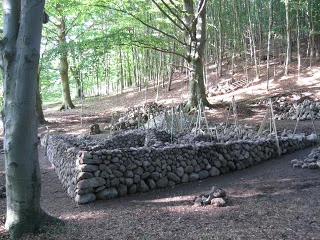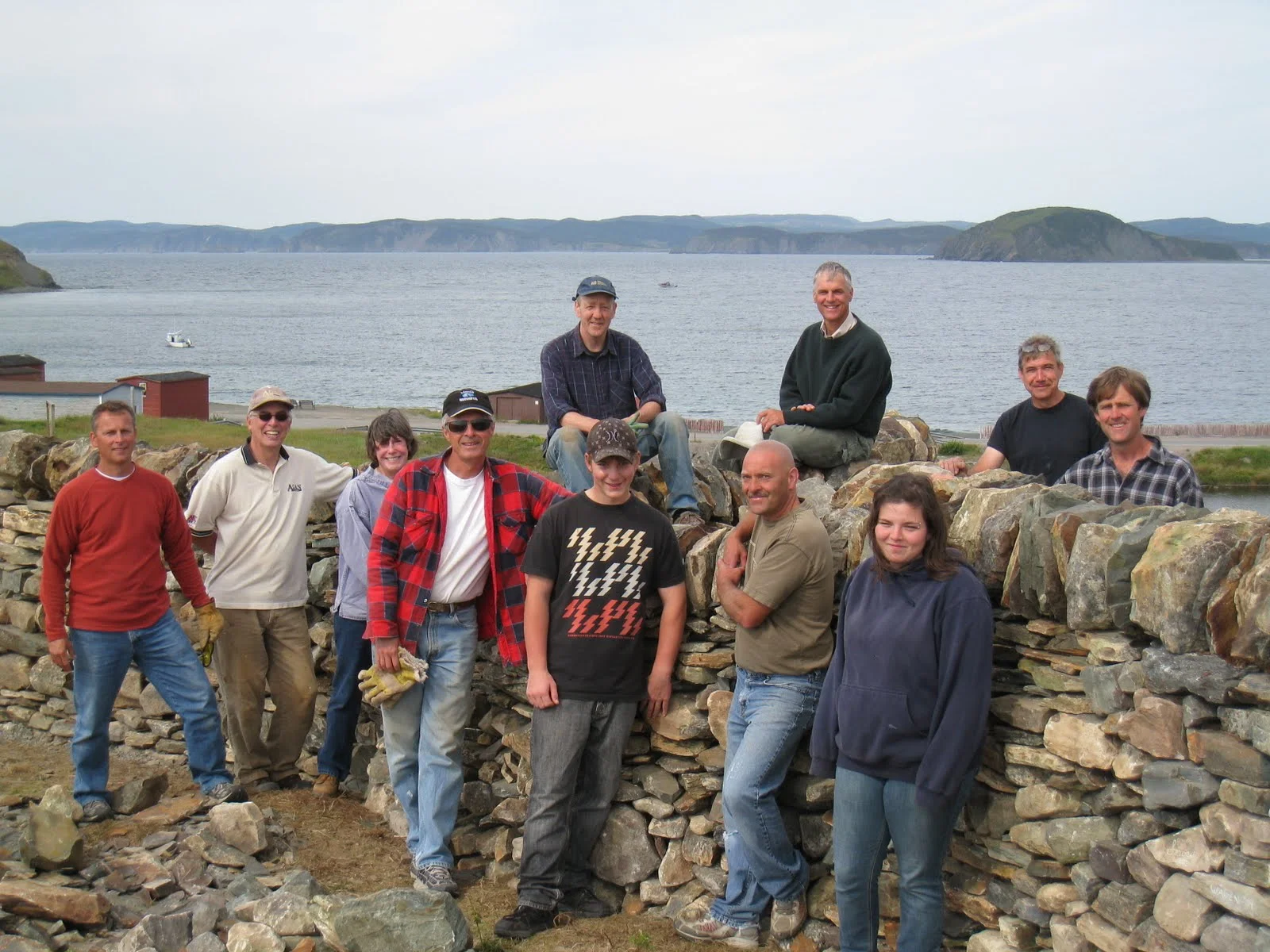The TICKON installation is past the halfway mark thanks to the help of Alfio Bonnano and Ole Johnsen who have coordinated all the logistics of tools and materials, plus, made us feel at home away from home. On site, Francesca and Jared have put in long hours raising the walls of the piece that will soon be the newest addition to the art park. Elin has been busy orchestrating the myriad details of working and living away from Vermont, and documenting the process and progress of the installation.
Read MoreIt took me a few days to ‘get’ TICKON’s method of operation but I can now appreciate it for its full value. The art park owns no tools or equipment. Everything needed to produce a new installation is gathered piecemeal from community members in the surrounding villages. So, for the first few days of my project I rode around the countryside with Ole each morning popping in on local folk to have a chat. We explained what the project was, and what we were looking for. Eventually the tools and materials came together. In the process, more and more people became involved in the project. They have helped to create a new art work at TICKON. “Mange tak” to all those who have made me feel welcome in the Kommune of Langeland.
Read MoreWhile the supply was drying out I began setting up batter frames. Each board describes an inside corner of the construction. Because the wall intersections are many different obtuse and acute angles, each board is set to correspond to the intersection angle and to the wall batter. The wall batter is 2.5” in every 12” of vertical height. Work on the piece begins at the center and moves out toward the perimeter as progress is made over the next few weeks.
Read MoreThe previous post elicited a question from a reader about the dry stone cairn in the top photo. It’s a trail marker, one of hundreds found alongside the old routes in Norway for crossing the high country from one valley community to another. They are spaced approximately 50 meters apart to help guide those traveling in fog, snow or low light conditions. The pine poles atop them may be all that’s visible in a sea of winter white.
Read MoreFrom the glacier fed streams of Norway’s Jotunheimen mountains, I’ve traveled this past week to the low, wetlands of Denmark. In fact, I’m living in a 300 year-old house alongside a castle moat. This is the artist’s residence for TICKON, the environmental art park I’ll be working in for the next month. Yesterday 20 tons of stone was gathered from field piles and delivered by the tractor-wagon load to the site of my construction. Today the outline of the work will be established and guide frames erected.
Read MoreContinuing on the subject of sculpture gardens, here’s a nice example I saw yesterday outside the Art Museum in Lillehammer, Norway. Created in 1992 by Bard Breivik, the sculptured garden is a cascade of stone and water. It begins serenely on flat ground at the height of the space. There, a screen of vertical granite slabs encloses a dry courtyard, a green lawn is bisected by a flagstone path, and the water course begins by spilling from a granite monolith into a long, stone trough. The water descends in multiple streams through a series of channels to a reflecting pool at the bottom of a steep rockery. Breivik’s sculptured garden is a good example of art that interprets nature without imitating it.
Read MoreLast night the sky over the harbor was totally star-twinkled. From the bay, which was uncharacteristically placid, came the "whooshing" sound of whales' breaths. The huge animals rhythmically rose to the water's surface in the darkness, exhaling plumes of sea mist. They were invisible to the eye but must have been very close to shore. The 'squeaks' and 'squawks' of their aquatic songs reverberated around the bay. The sonic echoes were hauntingly beautiful but their meaning lost on my land-locked ears.
Read MoreCultivated land is a handmade environment. In centuries past, the face of Newfoundland was shaped by domestic agricultural activity. While many of the stone walls built during those times have lost their stature as fences, their presence remains a defining characteristic of the land. The close attention that farmers paid to their surroundings is comparable to the awareness artists bring to their work. Dry stone construction is a logical medium of expression for an artist working in the landscape.
Read MoreBelow is the gist of my presentation for the artist’s seminar that preceded the opening of the show at Kerava Art Museum yesterday. The title and theme for this exhibition is ‘Hole in the Universe’. I don’t know how it sounds in Finnish but the word ‘hole’, in English, can be heard as ‘whole’; with a ‘w’. So the title, when spoken, can be interpreted in two ways. Both are interesting concepts to ponder, and respond to by making art. A hole can be a void, a container or a passage way. To become whole in the universe, complete in mind, body and soul, is perhaps the ultimate artists’ quest.
Read MoreThe techniques used to set stones in relation to one another can be varied. The sizes and shapes of the stones in any supply are often the final determining factor in the design of a dry stone structure. The supply limits the possibilities, focusing the process of design on what is doable. Limits actually increase the potential for a successful outcome. By first assessing the qualities of the available stone, a more ornamental or contemporary design might be considered and pursued.
Read MoreThe dry stone sculpture rising out of the lawn outside Kerava Art Museum is beginning to attract local attention. People on their way to work are slowing down as they pass. Some stop and ask what’s happening. I learned through a student interpreter that one fellow said he liked seeing natural stone being used, that every one has a unique and beautiful shape. The people of Finland are surrounded by rock. Even in central Helsinki, bedrock outcrops are everywhere. Stone is only surpassed by forest and water in defining the nature of the landscape, and the psyche of the Finns.
Read MoreThe first full day of sculpture making at Kerava Art Museum brought one form to completion. Because this is a temporary exhibit, I’m building directly on the lawn grass. The granite pebbles and cobbles are easy to handle and a nice change of pace from heavy lifting, even though I do have to spend most of the day on my knees. Their smoothness makes them a bit slippery. I wouldn’t recommend using them this way for a permanent construction. This type of arrangement is like making a big ring cake out of small potatoes. Thanks to students Lauri, Hannah and Iisa for set-up assistance. And to Jenni M. for stone shifting.
Read MoreYesterday, Professor Markku Hakuri took me for a train and bus ride to check out the site for my installation at the Kerava Art Museum. This morning I went ten miles outside of Helsinki to a look at gravel pit. A ‘tailings’ pile I found there has the right ingredients for making a piece that combines twelve hollow cones into a mound shape. Because a group of university art students will be helping me, it’s important that the stones be easily shifted and lifted by hand, and the cones and mound be definable with lines and guide frames. This afternoon I made a 3-D sketch in clay of the design I’ve been working on in my head for the past couple of days.
Read MoreCultivated land is a handmade environment. Over the past two centuries, the rural face of Vermont has been shaped by farm life. While the stone walls built during that time have lost their stature as livestock fences, their presence has become a defining characteristic of the land. A dry laid stone wall, that has stood the test of time, is praised for its practicality, durability and craftsmanship. The close attention farmers pay to their surroundings is comparable to the awareness artists bring to their work. As a medium of expression, dry stone construction is a logical choice for an artist working in the landscape.
Read MoreThe Sheep Shed resides at the convergence of two paths trodden into the hillside by many generations of sheep hooves. Three dry stone walls, built from cobbles and boulders selected from a gravel pit, support oak timbers. A light weight network of spruce log poles rests on the frame. In ascending layers, thick slabs of flat stone from a quarry in Goshen, Massachusetts cover the pole rafters. The roof stones are not affixed in any way. They are held in place by the sheer weight of their collective mass. Twenty tons of stone float over the void of the sheep shed interior.
Read More













